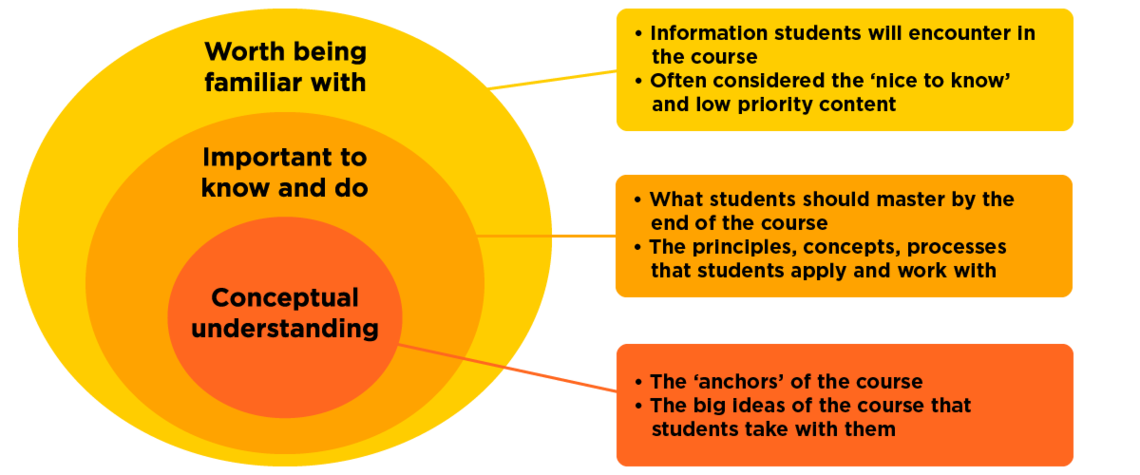Prioritizing course material
In an adaptable course design, prioritizing course material means instructors can reduce the extraneous load for students, and focus on the essential need-to-know information, activities, assessment, and how students can access that information.
Use the following worksheet to help prioritize content and begin to conceptualize how to plan flexibility in content delivery and access.
-
Consider workload and where you can prioritize course material.
-
Could a scheduled class be replaced with a video and an activity?
-
Could one unit of content be removed, and the remaining content be spread out over the semester?
-
Could online methods to deliver content such as videos, online text, open educational resources, and other sources be used to increase accessibility?
-
-
Consider how in-person activities can be transitioned online.
-
Could lectures be pre-recorded as short videos and online synchronous time be used for questions from students?
-
Could teaching activities be adapted to include small group work, online discussions or using online collaborative platforms?
-
Could activity instructions be provided in written, video and/or audio format in D2L?
-
-
Consider using flexible assessment strategies that can be adapted to different learning environments.
-
Could an in-person exam be adapted to a take-home exam?
-
Could rubrics be modified to ensure clear assignment instructions to help students keep on track and know what is expected of them?
-
Could alternative assessments be considered and submitted online?
-
-
Consider incorporating activities that encourage students to connect with each other and the instructor.
-
Could D2L be organized so students are in small study groups?
-
Could an introductory video be created and posted into D2L to increase instructor visibility?
-
Could a D2L FAQ discussion thread be created to answer common questions?
-

Figure 2: Content prioritization (Adapted from Wiggins & McTighe (2005)
Optimizing student learning
Disruptions to the semester that require a transition to online or blended learning may impact student motivation, engagement, and their connection to peers, instructor, and course material. Universal Design for Learning (UDL) can help spark and sustain student curiosity, interest, and promote self-regulated learning during unexpected disruptions in learning spaces (CAST).
Students can become more distracted during disruption. One way to address this challenge is to adapt your lesson into deliberate sections that hold students' attention and progressively move them through points of engagement with the content to gain a fresh point of reference and help them settle back into their learning.
-
5E Instructional Model
Example: The 5E Instructional Model is a lesson planning tool that supports adaptable teaching by breaking down Engagement into five parts: Engage, Explore, Explain, Elaborate and Evaluate.
Although the phases in this model follow a linear progression, an adaptable lesson design would consider how:
-
Each 5E phase informs one another from any starting point
-
The scope of the task in a 5E lesson can be adjusted to span the duration of one class, days, or weeks
Resources: Use any of the 5E’s in the instructional model templates below to adjust an existing lesson or create a new learning opportunity:
-
In adaptable course design, curating content and lesson activities with hyperlinks can help students spend less time searching for what they need.
This can help increase student motivation to revisit what is relevant to their learning in your course with ease. Using hyperlinks could create more opportunities for active learning in online or blended learning environments by streamlining some course materials.
-
Hyperdocs
Example: A Hyperdoc is an interactive adaptable teaching tool that encourages:
-
Student motivation and ease of course navigation and wayfinding
-
Fewer lectures and more interactive learning
-
Student self-direction and learning at their own pace
Resources: Use any of the following Hyperdoc templates to design interactive learning materials:
-
During disruptions, giving students more choice in how they complete their assignments demonstrates a learning-centered pedagogy where students can revise, improve, and resubmit their work to arrive at a stronger understanding of the classroom learning materials.
-
Choice boards
Example: Implementing Choice Boards (What are Choice Boards?) is an adaptable teaching strategy that provides a flexible, low-stakes assessment approach which encourages participation options for students to demonstrate evidence of their learning. Choice Boards can be a catalyst for learning that is:
-
Formative or Summative
-
Individual
-
Collaborative
-
Reflective
-
Experiential
Resources
-
-
Communicate efficiently with your students during disruption by:
-
Creating a video to explain the assignment rubric
-
Elaborating on a concept when students have difficulty understanding a topic
-
Communicating reminders and due dates in a News announcement, or providing students formal or informal feedback using audio feedback/video
-
-
Embed hyperlinks in your D2L course to:
-
Support student wayfinding and navigation in an online environment
-
Guide students to lesson materials checklists, activities, submission folders, and external resources
-
-
Add different assessment options to a D2L module by “Adding a New File” or an “Existing Activity”:
-
Create a short quiz to check for concept understanding
-
Consider including a “Choose Your Own Adventure” activity Template as an option for students to:
-
Demonstrate their learning by providing choices that determine diverse actions and outcomes
-
Provide students the option to “play” another student's activity and reflect on their actions and the outcome
-
-
Providing multiple pathways for students to participate and express their learning can be reflected in using learning technologies to promote alternative assessment methods that can better communicate student performance.
Lesson checklist
-
Review your course learning outcomes and assessment plan
-
Identify course elements that can be adapted to the online or blended environments
-
Complete the Adaptable Course Design worksheet
References
Bruff, D. (July 1, 2020). Adaptative course design: preparing for Fall 2020. https://cft.vanderbilt.edu/2020/07/adaptive-course-design-preparing-for-fall-2020/
McPeak, A. (2020, August 1). Adaptable Design: Building Multi-Modal Content for Flexible Law School Teaching. St. Louis University Law Journal, 65
https://ssrn.com/abstract=3665432
Wiggins, G. & McTighe, J. (2005). Understanding by design (2nd ed.). Alexandra, VA: ASCD.




